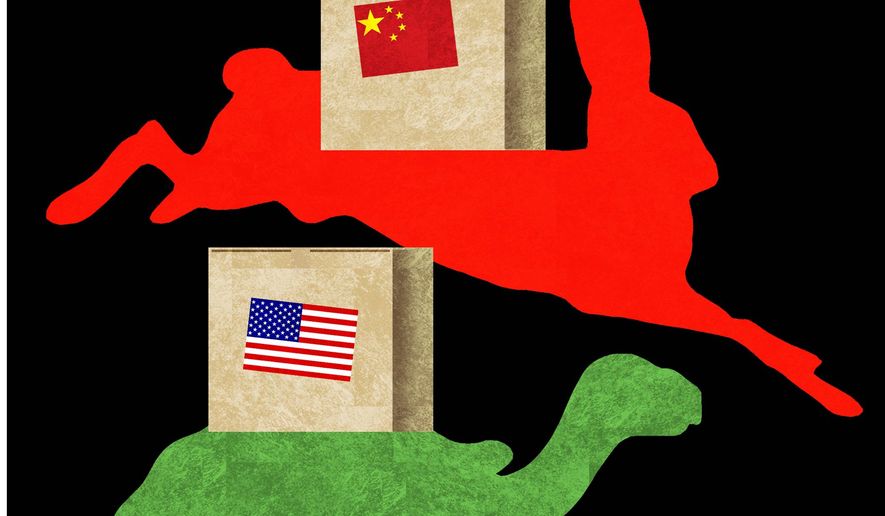OPINION:
Never has so much promising news about U.S. trade, and President Trump’s progress in bringing the nation’s trade deficits under control, been so deeply buried in an official economic report as in Wednesday’s Census Bureau release on America’s trade performance for last December, and for full-year 2018.
Yet never did such a survey ever make so clear two crucial, related conclusions: First, contrary to critics’ pervasive gloating, there’s little evidence that a predictable backfiring of Mr. Trump’s tariff-heavy policies has produced the apparent trade deficit backsliding revealed by the new numbers. Second, evidence actually abounds that urgently needed continued progress depends on doubling down on America First-style trade policies.
But thick clouds obscured these findings. After all, as widely reported, the new data showed the highest monthly and yearly total trade gaps since 2008 — as the financial crisis was turning into the Great Recession. Meanwhile, the monthly and annual trade shortfalls in goods were both the largest ever.
Nor did the trade numbers look better for two main Trump targets: The huge, chronic and closely related trade gaps in manufacturing, and with China (because manufactures dominate Sino-American trade). The former last year topped $1 trillion for the first time, and the China goods deficit hit a new record of $419.62 billion.
Never-Trumpers immediately and largely blamed the Trump trade curbs. The American tariffs had weakened U.S. companies versus foreign rivals by higher, tariff-generated prices of key inputs like metals. And they had undermined exports by spurring foreign retaliation, and slowing global growth by paralyzing businesses with uncertainty.
But the claim that more expensive steel and aluminum have already hamstrung American competitiveness ignores the out-performance of U.S. metals-using industries since the tariffs began in terms of output growth, hiring increases and other key indicators. (The jury is still largely out on the more recent China levies’ impact.) Moreover, despite foreign retaliation and supposedly jittery CEOs, the nation’s non-oil goods exports (the trade flows most susceptible to trade policymaking) actually grew faster before inflation in 2018 (4.97 percent), than the year before (4.31 percent).
Further, the new trade data show continued progress toward two major Trump goals (and campaign promises): Achieving satisfactory growth while slowing the rise of the trade shortfalls both with China and in manufacturing. Therefore, the economy is expanding more through its own devices — by producing more of the goods and services it consumes — and less through debt-financed consumption.
Specifically, in pre-inflation terms during 2017, the China goods trade deficit grew 1.98 times faster than the economy as a whole, and 2.23 times faster than the economy last year. Those figures are higher than some annual results earlier in the current economic recovery, under the Obama administration. But those earlier growth rates themselves were generally slower, too. More importantly, when they sped up, as in 2011 and 2013, the goods trade deficit with China tended to balloon.
In addition, this year’s U.S. merchandise imports from China have been artificially inflated by tariff front-running — i.e., China-based exporters rushing shipments to America to avoid anticipated trade curbs. Because bilateral trade is so seasonal, statistics for the third and fourth quarters of the last few years are especially revealing.
Consistent with the pattern of U.S. goods imports from China peaking in the third quarter, during the July-September period of 2017, before the China trade conflict began, these purchases grew 2.3 times faster than the overall economy before adjusting for inflation. And in the fourth quarter, China import growth slowed to only 88 percent the total economic growth rate.
In the third quarter of 2018, though, the gap between China imports growth and overall U.S. economic growth was wider — the former was three times the latter. But in the fourth quarter, even though the American economy was expanding nearly as fast as in 2017’s comparable period, U.S merchandise purchases from China actually dropped.
These trends have been even more striking in manufacturing. During the pre-Trump phase of the current economic recovery, brief periods of robust growth generally took place when the manufacturing trade deficit expanded many times faster. In 2014, for example, the latter grew 2.79 times faster than the former. In 2015, the ratio was 3.31-to-one.
During the last two years’ quickened overall economic growth, the manufacturing trade deficit has widened at less than twice the rate of economic expansion. And as with the China deficit, the 2.11-to-one ratio for 2018 has been propped up by tariff front-running.
Unfortunately, further, lasting trade deficit progress is no guarantee. In particular, a China deal exchanging more purchases from the United States for unenforceable promises of structural reforms may temporarily narrow the trade gap. But longer term, the shortfall may become more concentrated in high value goods, as China’s economic predation keeps strengthening its advanced industries at America’s expense. Rescinding current tariffs could worsen the deficit quantitatively as well.
Higher, broader levies would be much better — not to achieve the chimera of verifiable Chinese reform, but to continue U.S. disengagement from this economic rogue.
Sharper trade policy messaging would help, too. Trade wars for a largely self-sufficient economy like America’s actually are pretty easy to win. But not quickly. Faster, healthier recent growth vindicates the president’s original trade policies and other economic initiatives. And polls indicate he’s receiving much credit. So staying the course and cooling the over-promising is his best bet for continued success economically — and politically.
• Alan Tonelson, founder of RealityChek, a public policy blog focusing on economics and national security, is the author of “The Race to the Bottom” (Westview Press, 2002).




Please read our comment policy before commenting.